Marlins and more in Magdalena Bay
Although striped marlins (Kajikia audax) are slower than some of their billfish cousins, their 50-mph speed is plenty fast for me. I try to swim alongside this stealth bomber of the sea as it works a baitball to separate individual sardines from the silvery mass.
While getting outpaced by sailfish and black marlin might be important to striped marlins trying to elude predation, they are so much faster than freediving humans that we don’t usually get close to one. But the Mexico sardine run isn’t normal circumstances, and the marlins aren’t swimming away. They are swimming around, over, under, and through a baitball. If you can stay with the baitball, you can stay with the marlins.
For this reason, underwater photographic encounters with marlins are now very popular in Mexico. It also helps that travel to Mexico is relatively easy, and the seasonal reliability of the sardine aggregations and the attendant predators provides a high probability of a successful encounter. It’s the wild ocean and not an aquarium, so there are no guarantees, but divers and dive operators have refined the protocols for finding baitballs. Sailfish appear off the coast of Isla Mujeres and Cancun from January through March, and striped marlins are accessible at Magdalena Bay on the west coast of Baja California Sur from November through January.
Small pelagic fishes (sardines, anchovies, and mackerels) travel within the California Current, and the timing and location of their congregations influence the upper trophic levels in the food web. The North Pacific Current splits near British Columbia — the Alaska Current runs north to Alaska, while the California Current travels southward along the West Coast to Baja California. The small pelagics in the California Current are sensitive to environmental changes such as El Niño, making them susceptible to any resulting water variations.
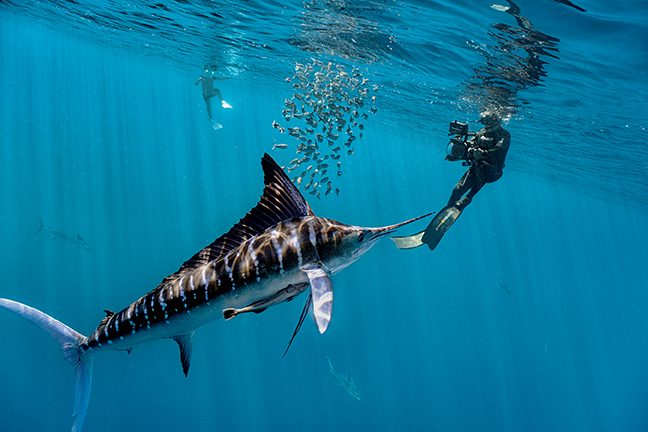
Researchers have identified three peak locations along the southern part of Baja where the sardines spawn, lay eggs, hatch, and mature: Magdalena Bay, Golden Gate Bank near Cabo San Lucas, and Finger Bank, a seamount near Todos Santos. Protected from the Pacific Ocean by the uninhabited sandy barrier islands of Isla Magdalena and Isla Santa Margarita, Magdalena Bay (Bahía Magdalena) spans 31 miles along the western coast of the Mexican state of Baja California Sur. By autumn, the sardines have matured enough to attract large predators such as bonitos, striped marlins, Pacific sailfish, sea lions, and even Bryde’s whales.
Finding a submerged ball of sardines in the open ocean is extremely unlikely by happenstance. Successful encounters occur when divers adopt the same protocols as the seasoned skippers of the sportfishing fleets, who travel 15 to 20 miles out to sea and typically 40 to 50 miles south of San Carlos. The frigatebirds follow the sardines, and we follow the frigatebirds. They are our eyes in the sky.
Frigatebirds search for a meal by flying high enough to see through the water’s surface to the frenzied activity below. As the birds find the baitball, their flight posture changes, and they circle while skimming low over the water. We approach and see the disturbance on the water’s surface as the swarming sardines jump out of the water, creating shiny waves of spray and a cacophony of swishes and splashes as thousands of sardines seek to escape the striped marlins below only to be scooped up by the frigatebirds above. The sardines’ bad luck is our good fortune as we embark on an extraordinary dive adventure.
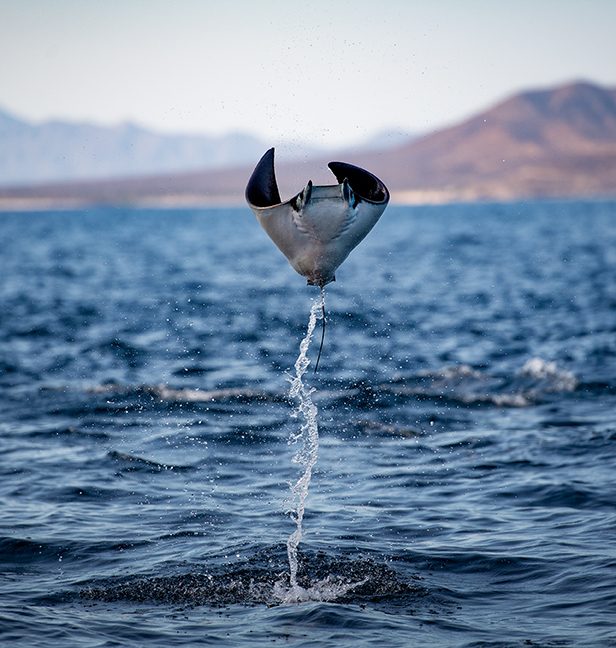
“Go, go, go!” the divemaster screams at us. I jump into the warm water and search left, right, and below. The visibility is at least 80 feet, but I don’t see anything until a dozen or more striped marlins suddenly appear out of the blue. I continue swimming and kick harder in the direction the marlins are going. Tracking the marlins is tiring, but I keep swimming, confident they know where they are going even if I don’t. Then at the edge of my visibility I see something big, round, and dynamic.
As I close the distance, the sphere coalesces into a frenzied, swirling mass of small silvery fish. The marlins were already on the attack. One after another, the marlins race toward the prey, raising their sails, with their bodies streaming silver and blue and reflecting dabs of yellow from the fading afternoon glow. Shaking their tails, they speed toward the baitball and then execute an impossibly tight turn to close in on the terrified sardines. The full power of their fearsome bills is on display as they bisect the baitball and collide with the helpless fish.
I am glad digital photography doesn’t limit me to only 36 shots as film did. How could I possibly pace myself with all the constant action? Gratefully, I don’t have to, so I keep photographing the scene.
You will see a range of cameras from smartphones to large digital single-lens reflex and mirrorless cameras. The action occurs in shallow water, and most shooters don’t need strobes …
Some sea lions join the hunt and help the marlins with corralling the sardines close to the surface to make feeding easier. The marlins are more cautious about attacking the baitball when the sea lions are around and search for space between the sea lions’ attacks, perhaps as a precaution to avoid breaking their fragile bills by dashing them against the sea lions.
As more sea lions arrive and gorge themselves on the sardines, the marlins withdraw to search for another baitball. Fortunately, many other such aggregations are in the open ocean outside Magdalena Bay.
You might think there would be competition between freedivers who want to see a marlin underwater and the fishers who want to catch and land a billfish. As diving with marlins has grown in popularity among in-water enthusiasts, however, tourist dollars have benefitted the local San Carlos fishing community. Many skippers there joined together and created a union. Fishers have turned to ecotourism, through which they make more money than before, put less pressure on the billfish populations, and ultimately are more aware of conservation and sustainability.
The area now has an influx of people from all over the world. The action attracts commercial and sportfishing yachts, television and movie productions, and pure nature lovers. You will see a range of cameras from smartphones to large digital single-lens reflex and mirrorless cameras. The action occurs in shallow water, and most shooters don’t need strobes, making for less resistance in the water and greater ease of getting in and out of the panga. During the peak season in November, half a dozen to a dozen vessels might be relatively nearby, but they won’t all be on the same baitball.
Local operators work together in a loose tourism co-op and communicate via marine radio, inviting others to share their good fortune when they find a promising baitball. With their collaborative mindset, it is almost certain that all visiting tourists will return home with stories and images to share. The local guides work hard to train their guests how to safely approach the baitball without being intrusive. Marlins will leave when people get too close to the baitball, so the objective is to observe without pressuring the marine life.
Local panga operators follow safety protocols, including staying in radio contact with their home base and each other, always returning to shore before nightfall, and reporting when they leave the action zone. They generally travel back to port together in a loose flotilla at the end of the day, which is a prudent arrangement for small boats with single outboard motors 40 miles offshore
Weather plays a crucial role in dive travel to this remote area with limited rescue services. Operators will sometimes suspend their trips, particularly when there are strong winds. Instead of heading out to sea, the skippers will operate within the more protected waters of Magdalena Bay. While it may not be the intended destination, the bay can also offer fascinating encounters. An extensive sand dune zone on the northwest corner of the bay has elaborate water channels and a healthy mangrove habitat. There is a vibrant population of fish, cormorants, pelicans, and other bird species. You may even see a coyote or a bald eagle. This mangrove wonderland might not be the hook that brings you to Magdalena Bay, but the time you spend exploring the mountainous Isla Magdalena and Isla Santa Margarita will inspire you.
From November through January, the baitballs attract wildlife other than marlins, including tiger sharks. Tiger sharks change the vibe, so we stay vigilant and take the precaution of turning off bright video lights. The sharks are quite possessive of the baitball, and we are deferential to our place in the food chain.
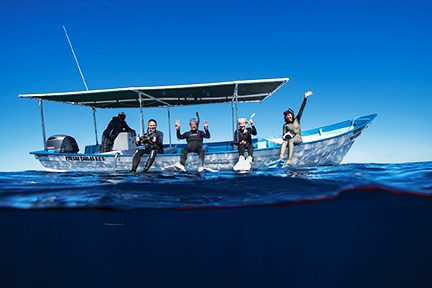
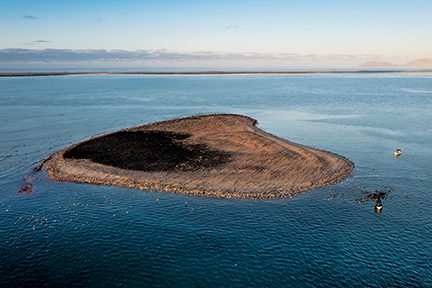
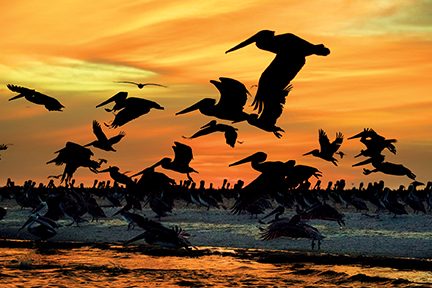
Bird Island is rewarded by seeing huge flocks of pelicans in flight.
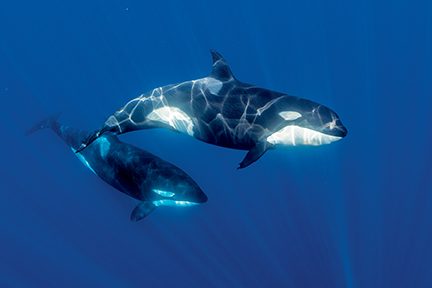
A pod of orcas visits two or three times during a season, generating much excitement. While we were sitting on the panga a burst of rapid conversation lit up the airwaves. Several pangas left their baitballs to rendezvous with the fisher who spotted the orcas and alerted his buddies. It was extraordinary to swim for two hours with a pod of six transient orcas. One of the females carried a piece of shark meat in her jaw and brought it is close to the panga. After taking a few images of her above water, my team and I joined the pod in the water for a peaceful and nonthreatening encounter — an experience that will never leave me.
In November and December humpback whales migrate south to the warm waters of Panama and Socorro to socialize and give birth. We were able to swim with a mother and calf several times. That same season, another team had a remarkable experience swimming with blue whales migrating south toward the Sea of Cortez.
Mobula ray encounters off Magdalena Bay are fantastic as well. When the sea was too rough to cruise to the sardine grounds and the wind had dispersed the frigatebird flocks, our experienced skipper suggested we head out to sea. After an hour or two of watching for whale spouts, someone saw a breaching mobula.
That’s one thing about the Mexican sardine run — it pays to be flexible. Whatever you thought you might photograph in the morning may not be the images you end up editing at the end of the day. Despite the change in plans, the massive school of mobulas made us very happy.
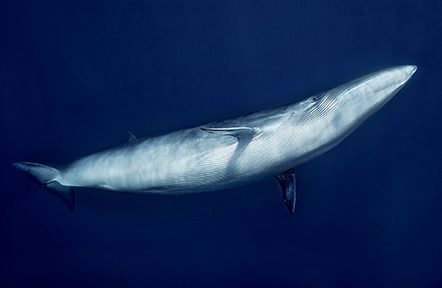
Our final notable encounter on this trip was with a Bryde’s whale. Although they are smaller cetaceans, slightly shorter and lighter than humpbacks, Bryde’s whales still take your breath away. The whales may quietly arrive while you are focused on a baitball or darting marlin. With their giant mouths gaping wide, they surprisingly swoop in and engulf almost all the baitball at once.
If you don’t mind getting up a bit early, you can head out to sea at 5:30 a.m. to see the sunrise over Bird Island. You won’t regret it. The island can accommodate thousands of cormorants and pelicans.
When looking at some of my drone footage taken from high enough above the island to avoid disrupting the birds below, I discovered the island is shaped like a heart. Only then did I discover the symbolic heart of Magdalena Bay, pulsing with life both above and below the sea.
How to Dive It
Sea lions can often join with the marlins gorging on a baitball.
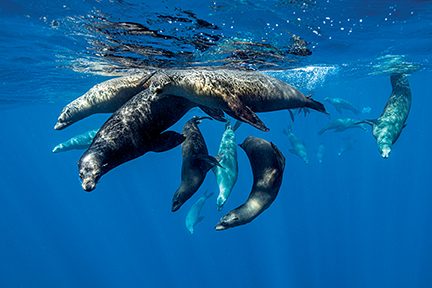
Getting there: Flights are available to Loreto, La Paz, and Los Cabos. Check with your tour operator regarding van transportation or car rental from the airport to San Carlos. The best time to travel to Magdalena Bay is November through January.
Accommodations: San Carlos has several basic hotels ranging from about $50 to $100 per night. All are safe and clean, and the Mexican food and drink from the local cantinas are wonderful.
Dive operators: A local fishing cooperative offers land-based diving operations on 25-foot pangas with outboard motors. Regional operators run liveaboards, and their schedules vary by season and preference.
Gear: Bring at least a mask, fins, and a snorkel. Freediving fins are not a must but will be more efficient for those with a powerful kick. A wind- and waterproof jacket, a warm fleece, sunscreen, and sunglasses are good to have.
Photography: All kinds of cameras will give you amazing images. Telephoto lenses are good for topside photos. There is such a wealth of photo opportunities you’ll want something to capture the scene. For underwater photography, plan for wide-angle to superwide lenses. You won’t need strobes.
Explore More
Watch a video of Amos Nachoum’s expedition to see striped marlins in Mexico.